Butterfly / Hummingbird Garden
God’s intricate and beautiful designs are on full display when we watch butterflies and hummingbirds. The Botanical Gardens at the Creation Museum were designed to attract these migratory marvels and to highlight God’s majesty.
Overview of Butterfly/Hummingbird Garden
You will see many varieties of plants, including butterfly bush, coneflower, and daisies, all of which attract and feed these precious pollinators. There are tall, native trees that provide shade, upright evergreens for year-round appeal, and even a shiny-leaf southern magnolia in the mix of plants in this area. A large waterfall runs through the center of the garden, traveling through dips and turns along and under the garden path on its way back to the Lake Garden. Guests are treated to an inviting visual display as they exit the museum doors by the grand staircase and look across the lake and through the pergola. These beautiful creatures, plants, and displays didn’t happen by chance: they are part of the intelligent design of the gardens, from the roots up!

Edward Goucher Glossy Abelia
Common Name: Edward Goucher Glossy Abelia
Botanical Name: Abelia grandiflora
Height: 3–5 ft.
Spread: 3–5 ft.
Location: Full sun to part shade
Bloom: May to September, white-pink flower
Hardiness zone 6–9
Beautiful funnel-shaped flowers grow abundantly on the new, dark green growth and persist until fall. This is a plant that is proven to be resilient, and it normally thrives in a variety of soil types. Abelias are generally deciduous, although they can be evergreen in warmer climates. Prune as needed in the spring to remove winter damage.

Crimson Queen Japanese Maple
Common Name: Crimson Queen Japanese Maple
Botanical Name: Acer palmatum var. dissectum
Height: 8–10 ft.
Spread: 10–12 ft.
Location: Full sun to part shade
Bloom: April, red foliage
Hardiness zone 5–8
The Crimson maple is a majestic plant adding appeal to any garden. It performs best if planted in an area somewhat protected from the wind. Even though full sun is listed, it will also survive best if planted in part shade, as new leaf growth can scorch in the heat. To prevent scorch, add mulch and keep the soil moist during hotter temperatures. Minimal pruning is needed and should only be done in the fall or early spring to prevent color bleeding.

Peacock Butterfly Bush
Common Name: Peacock Butterfly Bush
Botanical Name: Buddleia davidii
Height: 4–6 ft.
Spread: 3–6 ft.
Location: Full sun
Bloom: June to September, lavender-pink flower
Hardiness zone 5–9
Peacock is a newer Proven Winners variety of butterfly bush known to flower more abundantly and not spread as aggressively as other varieties. Full sun is preferred for this plant although it will survive in part shade with less flower production. Best if pruned to the ground in the late fall to early spring for the most vigorous seasonal growth.
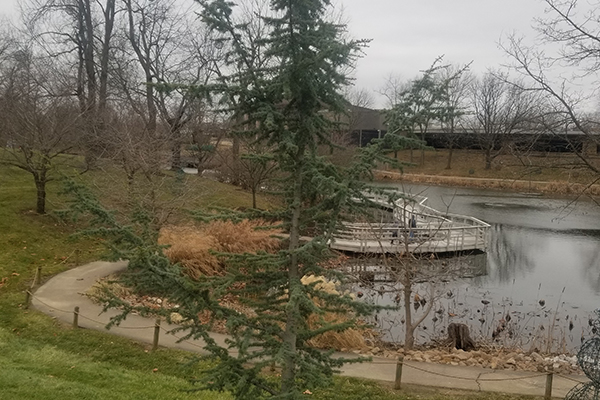
Cedar of Lebanon
Common Name: Cedar of Lebanon
Botanical Name: Cedrus libani
Height: 40–70 ft.
Spread: 30–60 ft.
Location: Full sun
Bloom: Non-flowering
Hardiness zone 6–9
The Cedar of Lebanon is a great symbol of strength and is mentioned multiple times in the Bible. This cedar was so sought after for construction and other uses that it was almost driven from existence. Now it stands strong, growing to 70 feet with branches close to the size of a trunk on mature specimens. A great, historic addition to any garden, give this evergreen tree some room when choosing a planting location.

Weeping Alaskan Cedar
Common Name: Weeping Alaskan Cedar
Botanical Name: Chamaecyparis nootkatensis “Pendula”
Height: 20–35 ft.
Spread: 8–12 ft.
Location: Full sun to part shade
Bloom: Non-flowering
Hardiness zone 4–7
This North American evergreen conifer with beautiful shredding and ridged bark is well adapted to most gardens. It could be used as an individual specimen or in a grouping for a larger area. This weeping cedar is a great example of why we need to know the scientific name of the plants that we care for. One could easily consider this in the cedar family from the common name, though it is not.

Golden Hinoki Cypress
Common Name: Golden Hinoki Cypress
Botanical Name: Chamaecyparis obtusa “Crippsii”
Height: 10–15 ft.
Spread: 8–10 ft.
Location: Full sun to part shade
Bloom: Non-blooming
Hardiness zone 4–9
Golden Hinoki has over a decade long cultivation track record making it a trusted selection for your garden as a proven performer. It is a broad and pyramidal plant with frond-like yellow/green new growth that holds the new growth color longer than most others. Even though some shade is preferred, full sun is usually not an issue.

Wolf Eyes Chinese Dogwood
Common Name: Wolf Eyes Chinese Dogwood
Botanical Name: Cornus kousa var. chinensis
Height: 15–20 ft.
Spread: 15–20 ft.
Location: Full sun to part shade
Bloom: May to June, pinkish-white
Hardiness zone 5–8
Normally dogwoods are understory plants that do not tolerate long periods of full sun. The Creation Museum is not following the rules and has grown a specimen that is thriving in full sun. The variegated leaf and large white flowers give so much interest to the garden. It also blooms later than Cornus florida, which is a factor to consider if you are staggering bloom times in your garden.

Magnus Coneflower
Common Name: Magnus Coneflower
Botanical Name: Echinacea purpurea
Height: 2–3 ft.
Spread: 1–2 ft.
Location: Full sun to part shade
Bloom: June to August, purple
Hardiness zone 3–9
This popular perennial with long-lasting flowers is commonly called purple coneflower. They are often mass-planted in a border or wildflower garden, but you can plant fewer in a smaller garden to attract butterflies and hummingbirds. If you leave the stem and spent flower on in the winter, it will provide another food source for some birds. Prune what is left to the ground in the spring.

Maidenhair Ginkgo Tree
Common Name: Maidenhair Ginkgo Tree
Botanical Name: Ginko biloba
Height: 50–80 ft.
Spread: 30–40 ft.
Location: Full sun
Bloom: April, green
Hardiness zone 3–8
Some call this a “fossil tree,” or living dinosaur, believed to be one of the oldest surviving plant families. Ginkgo is dioecious, meaning that there are separate male and female plants. The female variety is no longer in commerce due to its repugnant scent, so all unidentified seedlings should be avoided. The fan-shaped leaf adds to the attractive characteristics of this shade tree, but it puts on quite a show in the fall when the leaves turn a remarkable yellow.
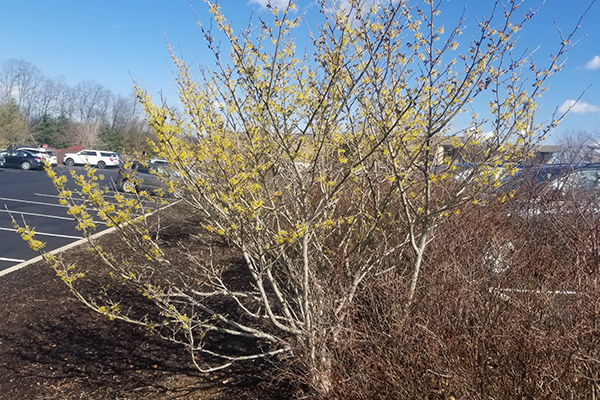
Vernal Witch Hazel
Common Name: Vernal Witch Hazel
Botanical Name: Hamamelis vernalis
Height: 6–10 ft.
Spread: 8–15 ft.
Location: Full sun to part shade
Bloom: January to April, yellow flower
Hardiness zone 4–8
Witch Hazel is a prized winter garden plant with a bloom time starting in January. It is usually a welcome sign that winter is coming to an end. Easy to grow, best suited in a woodland garden or as a screen or hedge. We have several of them under the swinging bridge where they have some freedom to grow. The leaves turn a golden yellow in the fall, which is also a good time to prune, as needed.
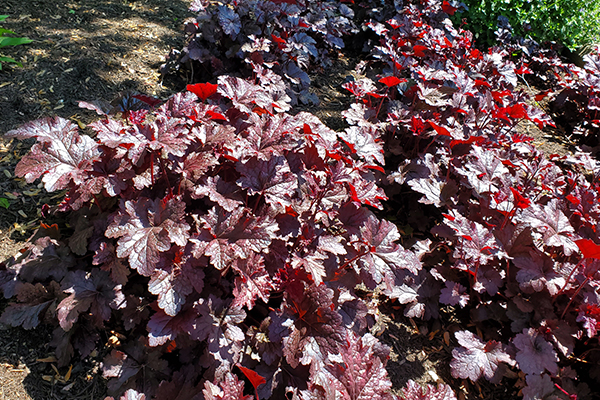
Palace Purple Coral Bells
Common Name: Palace Purple Coral Bells
Botanical Name: Heuchera micrantha var. diversifolia
Height: 1–2 ft.
Spread: 1–1.5 ft.
Location: Full sun to part shade
Bloom: June to July, white flower
Hardiness zone 4–9
The very large, purple/bronze star-shaped leaf is one characteristic that makes this award winner in the Heuchera family very popular with many gardeners. As a perennial plant, it will come back for you every year. It is easy to grow and requires little maintenance. It will look great along a border, in your rock garden, or in a planter. In late spring, there are groups of small, bell-shaped, white flowers on 20” high stems, giving great contrast to the foliage.
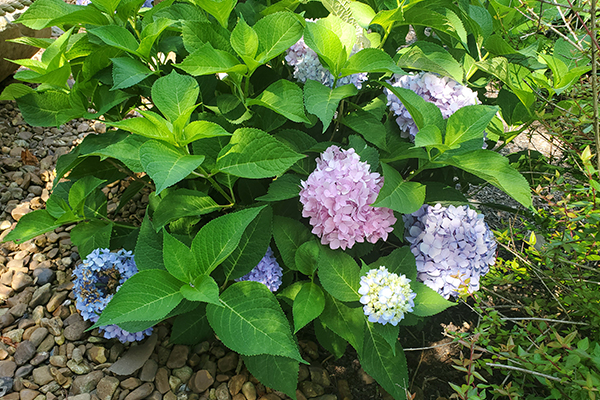
Endless Summer Hydrangea
Common Name: Endless Summer Hydrangea
Botanical Name: Hydrangea macrophylla
Height: 3–5 ft.
Spread: 3–5 ft.
Location: Part shade to full sun
Bloom: Seasonal, pink to blue
Hardiness zone 4–9
A major breakthrough occurred in 1998 when this reblooming variety was identified. Endless Summer blooms on old and new growth, making it unique. The unique flowers vary in color from blue to pink, depending on conditions in the soil. We have ours planted in a grouping, but an individual may also fit in your landscape.
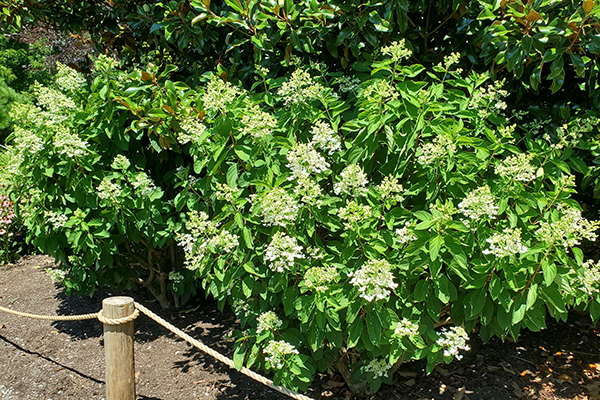
Chantilly Lace Hydrangea
Common Name: Chantilly Lace Hydrangea
Botanical Name: Hydrangea paniculata
Height: 4–6 ft.
Spread: 4–6 ft.
Location: Full sun to part shade
Bloom: July to September, white flower
Hardiness zone 3–9
Chantilly has the darkest green leaf of any other in this family. The strong ascending branches do not fall over with the large, nine-inch blooms that emerge in June. It also holds its flower later into the fall than some others, adding value to this selection.

Bobo Hydrangea
Common Name: Bobo Hydrangea
Botanical Name: Hydrangea paniculata
Height: 2–3 ft.
Spread: 3–4 ft.
Location: Full sun to part shade
Bloom: July to September, white flower
Hardiness zone 3–8
Bobo is a dwarf variety that grows only to a height of three feet. It produces white flowers covering most of the plant all the way to the ground, which will brighten any spot in your garden. The flowers turn a pinkish color later in the season and then to brown in the fall, giving this plant a long season of interest. They have very few insect or disease problems, so they do not require a lot of your time.

Bracken’s Brown Beauty Magnolia
Common Name: Bracken’s Brown Beauty Magnolia
Botanical Name: Magnolia grandiflora
Height: 30–50 ft.
Spread: 15–25 ft.
Location: Full sun to part shade
Bloom: May to June, white flower
Hardiness zone 5–9
The southern magnolia will grow in Kentucky, but we are at the northern portion of its climate range. You may want to choose a spot with some wind protection in your garden if you plant one. The Bracken’s Brown leathery leaf is shiny on the top and brown on the bottom, giving it a bi-color, tropical appearance. The late Spring white flowers give way to cone-like clusters that release seeds in late summer.

Walker’s Low Catmint
Common Name: Walker’s Low Catmint
Botanical Name: Nepeta x faassenii
Height: 2–3 ft.
Spread: 2–3 ft.
Location: Full sun to part shade
Bloom: April to September, lavender flower
Hardiness zone 3–9
A good use for Catmint is as a border plant, as we have in the Butterfly Garden, but it can also be used as a ground cover. Walker’s Low is an award winner and is noted for its massive lavender flowers that continue to bloom into the early fall. To encourage new blooms, remove the old spent flowers, similar to most plant varieties. Walker’s will usually spread 2–3 feet, allowing you to cover a larger area with fewer plants. The seeds are sterile, so you will need to propagate by division.

Tanyosho Pine
Common Name: Tanyosho Pine
Botanical Name: Pinus densiflora “Umbraculifera”
Height: 12–20 ft.
Spread: 18–25 ft.
Location: Full sun
Bloom: Non-flowering
Hardiness zone 3–7
An upright, spreading evergreen pine that grows multiple trunks close to the ground. As they mature and some lower branches become more visible, like ours in the Butterfly and Hummingbird Garden, the orange bark becomes a superb characteristic. Although they are known to grow slowly, they mature to 20’ with an even wider umbrella-shaped top. Keep this in mind when selecting a location in your garden.
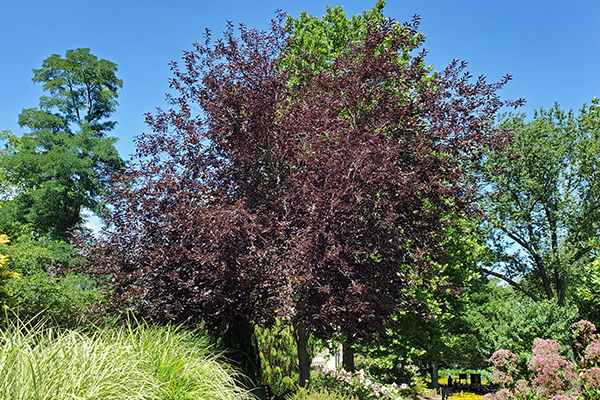
Schubert Canadian Red Cherry
Common Name: Schubert Canadian Red Cherry
Botanical Name: Prunus virginiana
Height: 20–30 ft.
Spread: 15–20 ft.
Location: Full sun to part shade
Bloom: April to May, white flower
Hardiness zone 2–7
Schubert is a deciduous, ornamental tree with small, white flowers and a uniquely interesting characteristic: It emerges in the spring with green leaves that turn a deep purple in early summer, which is really fun to watch. This tree is easy to grow, but some pruning is required to keep the suckering under control. As with any red-leaf plant, watch for beetles and other insects.
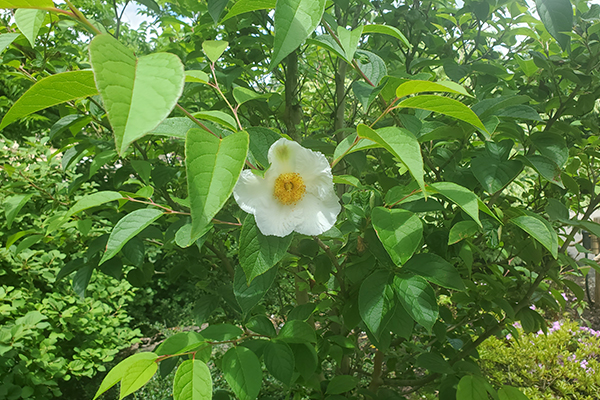
Japanese Stewartia
Common Name: Japanese Stewartia
Botanical Name: Stewartia pseudocamellia
Height: 12–40 ft.
Spread: 15–30 ft.
Location: Full sun to part shade
Bloom: June to July, white flower
Hardiness zone 5–8
This is a smaller, slower growing, somewhat pyramidal, deciduous tree with some interesting traits. The exfoliating bark ranges in color from orange to gray, adding year-round interest to your garden. As the botanical name implies, the flowers resemble a camellia flower and normally open in July. Stewartia has no serious insect or disease problems, making it easy to care for.
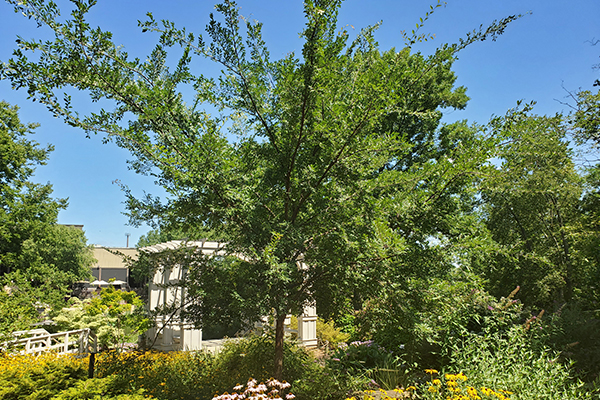
Allee Chinese Lacebark Elm
Common Name: Allee Chinese Lacebark Elm
Botanical Name: Ulmus parvifolia
Height: 60–70 ft.
Spread: 35–55 ft.
Location: Full sun
Bloom: August to September, small reddish-green
Hardiness zone 4–9
You can’t miss the bark! One of the best traits of this tree is the exfoliating, multi-colored bark giving year-round interest. The colors continue to become more vibrant as the tree matures. Allee is a rounded to vase-shaped deciduous tree with dark-green, oval-shaped, smaller-sized leaves. In time, it can grow to 70 feet, making a great canopy in your garden.